As I’ve gotten older I have done my best to adopt the idea of “working smarter, not harder”. One of the best investments I have made to help do this is to buy a hitch mounted truck crane. It’s great for lifting heavy items and setting them in and out of the back of your pickup truck. Why run the risk of hurting yourself by lifting something too heavy when there is a tool made to help in these situations.
Hitch mounted cranes are particularly useful when you have nobody around to help you. You can easily load things in your truck, take them where they’re needed, and unload them all by yourself. Having this ability is awesome.
In this article, I am going to go over some of the features of my truck crane and point out some of the things I like about it and a couple of the things I don’t like about it. My hope is to give you enough information to help you select a truck crane that will work for you and any specific lifting needs you may have.
Although this is not an official product review of my crane, I will be discussing it and providing an affiliate link to it and a few other products in this article. Therefore I am required to let you know that if you click on one of these links and make a purchase I could make a small commission at no extra cost to you. These commissions help support our website so we can continue to produce articles like this.
Important Hitch Mounted Crane Features
Table of Contents
At the time I purchased my crane several years ago, it was under $200. I couldn’t buy the hydraulic pump, cable winch, steel, and build it for that price. Since buying it and using it for a few years, I have not been disappointed. I would like to share some of its features and limitations that can help you pick the right crane for you.
Hitch Mounted Truck Cranes Are Portable
Number one on the list is hitch mounted cranes are completely portable. They can be used on any vehicle with a 2” tube hitch receiver. They are not mounted inside the truck bed. Those types of truck cranes require drilling and truck bed reinforcement to install. If you decide to go the route of the permanently installed truck bed crane, many of the below features and limitations can still apply. You may want to read on to make sure you’re getting what you want and need.
Hitch Crane Lift Capacity And Reach
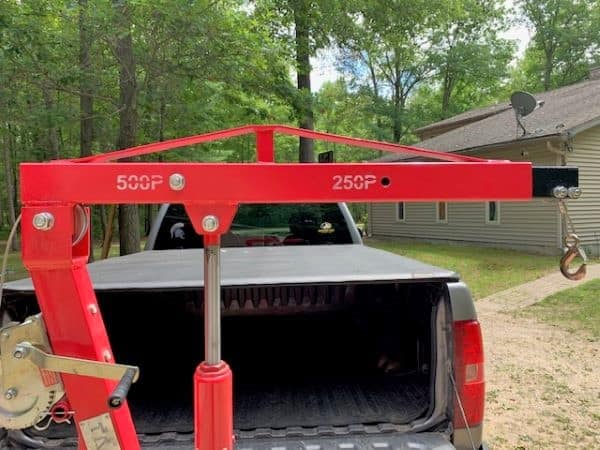
Let’s start by looking at the crane lift ratings on the hitch crane I bought. This particular crane has a two-position boom. With the boom fully retracted it can lift a maximum weight of 500 pounds. However, in this position, the boom reach is shorter and the lift high is reduced.
When the boom is in the extended position the lifting capacity is reduced to 250 pounds. However, in the extended position the reach is increased and so is the lifting height. This is typical for most truck cranes whether they are equipped with just the hydraulic jack lift or the have the cable winch as well.
The pictures below illustrate the boom positions of the crane I have and their associated reach limits. You will note that in the fully extended position (250-pounds) it may be tricky getting a larger item into the truck bed between the crane mast and the side of the truck box. With that said, I have had good luck with loading everything in my truck bed using my crane in the 500-pound position.
250 Pound Rating Reach Limits
500 Pound Rating Reach Limits
Hydraulic And Cable Lift System
Some hitch mounted truck cranes come equipped with both a hydraulic jack system to raise the boom and also a cable hoist that connects to the load being lifted. This is like the crane I am featuring in this article. The advantage of this style of a crane is the cable hoist is usually faster at lifting the load than using the hydraulic jack. The disadvantage is it appears that it may reduce the overall lifting capacity.
I say this because some models of hitch mounted cranes do not come with the cable hoist and most of them have a great lifting capacity. However, they come with a higher price tag as well. Here is a link to a hydraulic lift crane only example.
Crane Support Leg
Most hitch mounted truck cranes come with a “support leg” that extends down from the bottom of the crane mast. The support leg is there to help share some of the load that would otherwise be exerted on the truck’s hitch. This helps prevent damaging the hitch. The support leg should always be used.
What Can I Lift With A Truck Crane
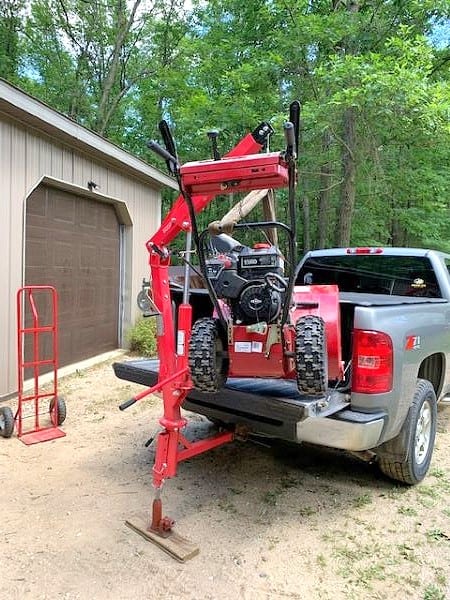
When I bought my truck crane I wanted it mainly for lifting just a few pieces of equipment in and out of the back of my truck. Since I’ve owned it that list has grown quite a bit. Below is a table of several of the items I commonly use my hitch mounted truck crane for. It also shows the approximate weight of each of these items. If you are going to be lifting similar items, a crane similar mine should work fine for you.
When you look at the list you will see a few items that seem very manageable when you see the weight. However, keep in mind many items are bulky, and awkward to get a good hold of by yourself. You also have to be able to lift them high enough to set on the tailgate. That’s not always easy. Truck cranes definitely solve that problem.
Home Equipment Weights
| Commonly Used Equipment | Equipment Weight |
|---|---|
| 3500 Watt Generator | 50 Pounds |
| 5000 Watt Generator | 65 Pounds |
| Welding (Lincoln AC Arc) | 50 Pounds |
| Pressure Washer | 25 Pounds |
| 28” Snowblower | 80 Pounds |
| Rototiller (front tiller) | 70 Pounds |
| Wheeled String Trimmer | 30 Pounds |
| Firewood (20” diameter x 18” oak) | 80 Pound |
| Whitetail Deer | 150 Pounds (average not field dressed) |
Note: These are just approximate weights of items I own and frequently use. The weights can vary a little based on several factors (manufacturer, model, size, etc…). This is only intended to give you an idea of what these cranes can be used for and to determine what size of hoist you may need.
To help make sure I didn’t overload my crane I invested in a small crane scale I use to verify the weights of things I am not certain of. The low cost of this 600-pound rated scale can give you real peace of mind. Coupled with following the crane manufacturer’s instruction, you’ll be able to make many safe lifts with your crane.
Hoist Mounted Crane Limitations
If you click on this link to the XtremepowerUS hitch mounted crane similar to mine, on Amazon, don’t let the images of it lifting the personal watercraft (PWC) deceive you. Don’t take me wrong, I love my lift, but it does have its limits. Let’s make sure you’re making purchasing decisions based on good information.
Just by looking at the pictures in this ad, I can tell it is in the extended position. As shown above, in the extended position this crane’s rating is 250 pounds. I did a little research and according to the “Steven In Sales” personal watercraft (PWC) website, the two lightest PWC’s currently made weigh in at about 300 and 400 pounds. In fact, they claim the average PWC weighs about 850 pounds. This is well above the crane’s ratings. Especially in the extended position. Not to mention the support leg in the photo is not down to help support the load. Making a lift like this can not only damage the crane itself, but it can stress and damage the hitch on your vehicle.
The main point here is no matter what hitch mounted truck crane you purchase, it’s very important to know the lifting capacity limits of the crane, the weight of the objects you’re lifting, and to follow the manufacturer’s directions. Please, don’t just look at the pictures. They can be a little misleading.
Hitch Mounted Crane Pros And Cons
As with many tools and equipment, there is a balance between costs and needs. Here are a few pros and cons that might help you make your decision on what hitch mounted truck crane will work for you.
Hitch Crane Pro’s
Hitch Crane Con’s
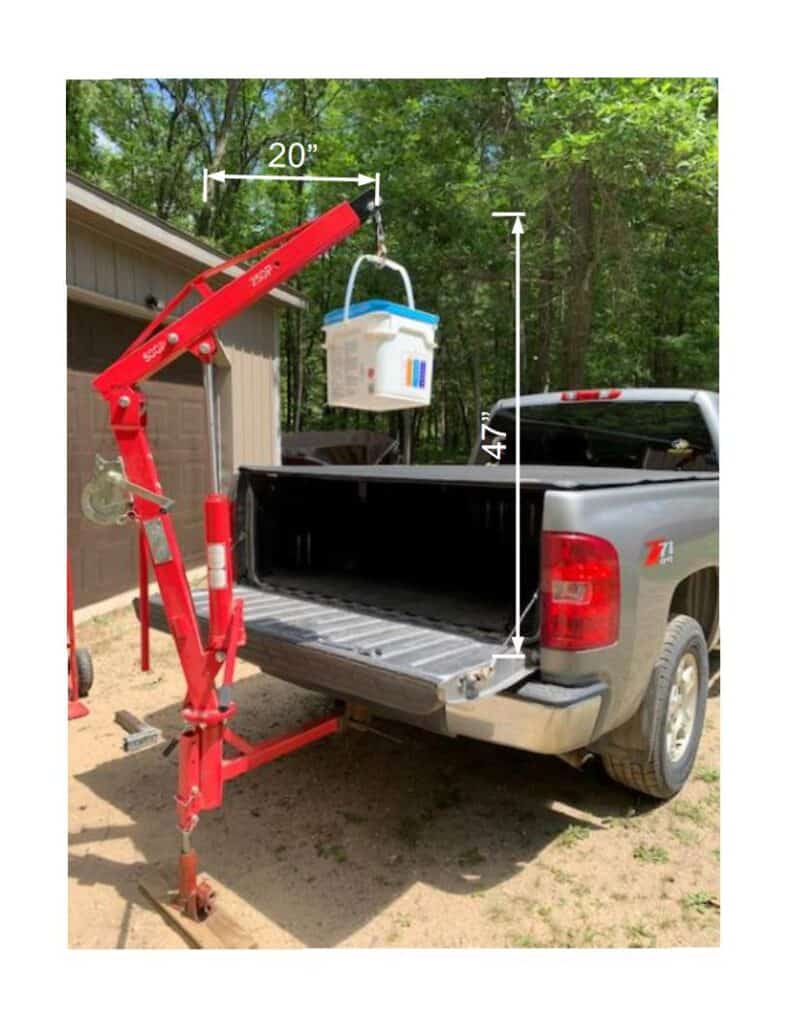
Tips For Using A Hitch Mounted Truck Crane
Of course, reading and following the manufacturer’s instructions and recommendations is a must. However, below are a few tips and tricks I’ve discovered and have used that will help make using your crane a little safer and easier.
Use On Level Ground
Most hitch mounted truck cranes are designed to lift a load and then swivel or swing it into the back of your truck. If you ever attempt to use the crane while set up on uneven ground, be aware that as soon as the load comes off the ground it can swing on its own. This can allow the load to hit you causing injury or to hit your truck causing damage.
Crane Support Leg Adjustment
When lifting something it’s always a good idea to use the support leg(s) according to the manufacturer’s instructions. However, if you are loading several heavy items in your truck, like some larger firewood pieces, be aware that as the load increases your truck suspension will “squat”.
This will put additional pressure on the support leg. So much so that you may not be able to pull the locking pins once the truck is full. If the load is heavy enough and the truck squats far enough, it could cause damage to the crane or the truck hitch. Be sure to check the support leg frequently and adjust the height to keep it from binding under the load in the truck.
Something I have started doing is to use a small jack (hydraulic or screw-type) under the support leg. This allows you to easily and quickly adjust the support leg height. Just be sure the jack remains securely in place while the crane is being used.
Cable Winch Use
On hitch mounted cranes with both the hydraulic boom and the cable winch, there are a couple of things you should know before operating the winch. When raising and lower your load with the winch there is a selector lever for up and down. When in the “up position” you can partially raise the load and stop, and the load will stay in that position. This is good for making sure the load is secure.
However, in the “down position“, if you let go of the winch handle, the load will begin to fall. Unfortunately, this is typical of this style winch. When this occurs, two bad things can happen. The first is the load will fall and possibly cause damage to it and/or your vehicle or cause injuries to you. The second hazard is as the load falls the handle on the winch will spin rapidly. Don’t try to grab it! The spinning handle can easily break or at least badly bruise your hand.
Just remember, when raising and lowering your load, slow and steady wins the race. If you are lower a load and need to stop, be sure to put the winch in the “up position” and make sure the load is secure before letting go of the winch handle.
Another little tip when using a crane equipped with both the hydraulic boom and cable winch is to be sure to leave the cable winch hook lowered a couple of inches before lowering the hydraulic boom. As the boom lowers the cable may naturally get pulled in an inch or two, depending on the crane’s design. If the hook is raised up tight against the boom, and the boom is lowered, it can put a lot of stress on the cable. This could possibly damage or break the cable if the load is very heavy.
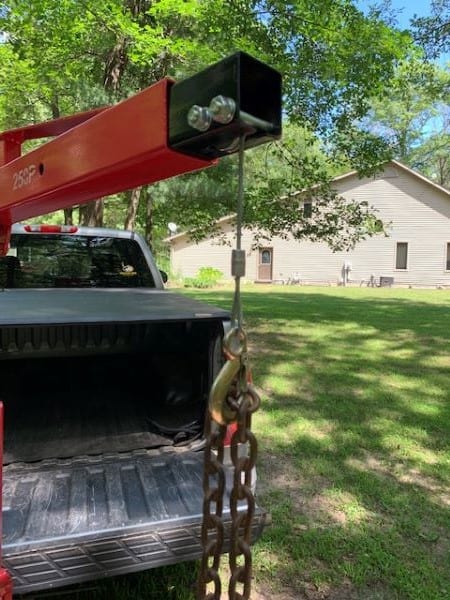
Lifting Devices
Once you have your crane you will find it is rare that you will be able to simply connect the crane hook up to something, lift it, and set it in the back of your truck. 99% of the time you will need some sort of “lifting device” to hook up to the load being lifted. This is called “rigging”.
Rigging devices include things like lifting slings and chains. I prefer using slings on the equipment you don’t want to be scratched. Also having a couple of different sized D ring shackles on hand is a good way to connect your slings to your load and to the crane hook.
When lifting larger items you’ll need to keep the rigging between the crane hook and load as short as possible. Having a good variety of lifting devices can be really handy for making good rigging connections. I only show one lifting sling in the picture below, but I have several others in varying lengths to help get good, level picks.
Each of these devices has lifting capacity ratings themselves, so be sure to know what those ratings. Also, how each device is used can decrease those ratings. It’s very important to read the manufactures instructions on how to use each lifting device properly.
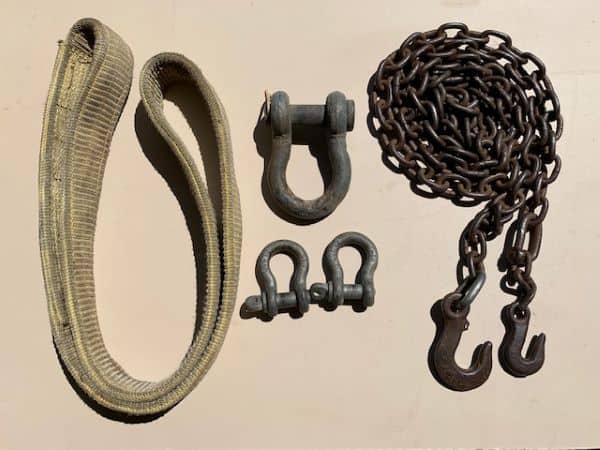
Properly rigging your load for lifting is very important. Always hook to something solid, like the frame on a piece of equipment or other solid lifting handholds. Be careful when connecting loads with a high “center of gravity” (COG). A good example of this is a rototiller. The engine sits high on the tiller and can be the heaviest part of the machine. The high COG can cause the load to flip upside down. Be sure to hook to these loads in two or three spots to help prevent this.
If you’ve never done any rigging before, I highly recommend reading these “Basic Hoisting and Rigging Guidelines” put out by the Princeton University Environment, Health, and Safety department. It’s a brief overview of what to look at and how to prepare for a safe lift.
Moving And Attaching A Hitch Crane
As mentioned above, these cranes are not exactly light and they’re a little awkward to handle. One of the easiest ways I’ve found for moving and handling is to use a two-wheeled hand truck. I use the hand truck to take it out to my truck, position it so the crane’s square tube is resting on the truck hitch receiver, and then lift the crane by hand until it slides into the truck receiver. I never have to lift the full weight of the crane.
Another important tip on the XtremepowerUS crane is to be sure to pin the support leg while installing and removing it, so it cannot slide freely. If left to slide freely, it can create a potential pinch point for fingers. Luckily I only had a close call!
Conclusion
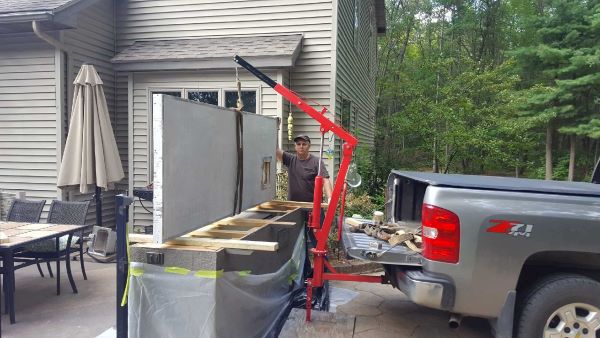
If you handle and haul any of the equipment or items I refer to above, then I’m pretty confident that you can benefit from owning a hitch mounted truck crane similar to mine. For the cost, it’s hard to beat. If you think you are going to be handling items in excess of 500 pounds, do your research before buying. Use the information above to help identity what will work best for you.
Don’t hurt yourself trying to lift something too heavy or awkwardly shaped. Invest in a hitch mount truck crane today so you’re prepared to haul your generator up to hunt camp this fall or for any other little surprises life can throw at you. Remember, work smarter, not harder.
If you have any comments or questions, you can leave them in the comments section below or you can email us at [email protected]. FYI, we do not collect or share email addresses. We will only use them to reply to your comments or provide answers to your questions. We are also required to let you know that some of our links are “affiliate links”. This means if you click on a link and make a purchase, we could make a small commission, at no extra cost to you. This helps offset the cost of maintaining our website. So, if you like what you’ve seen, please be sure to give us a “Like” and “Share” on Facebook and Instagram too. Thank you for reading and good luck with all your home projects!

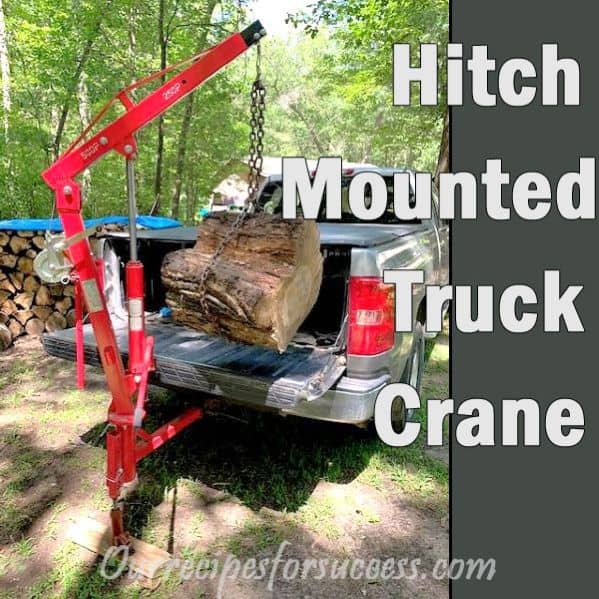



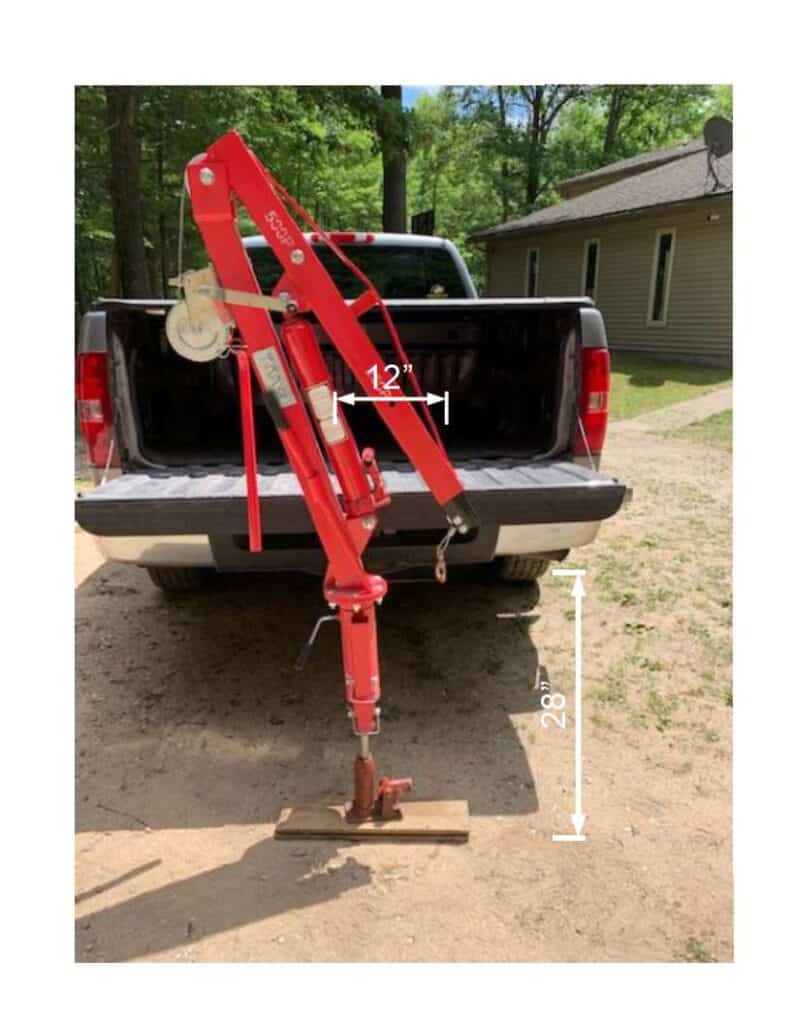
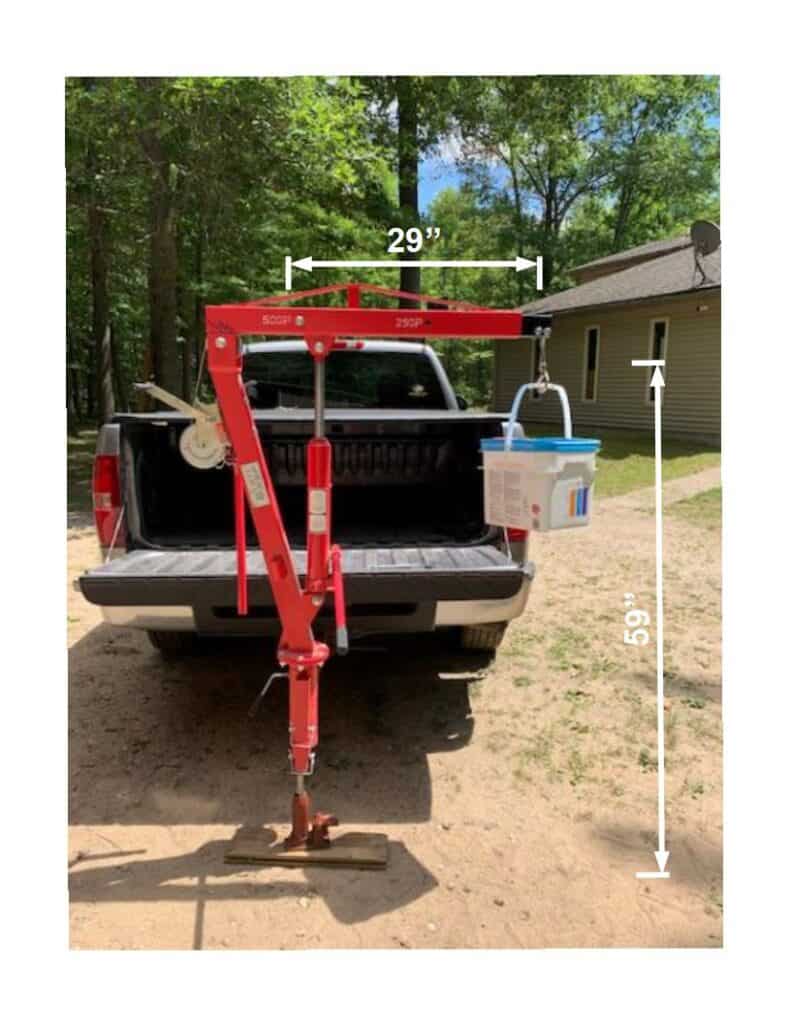

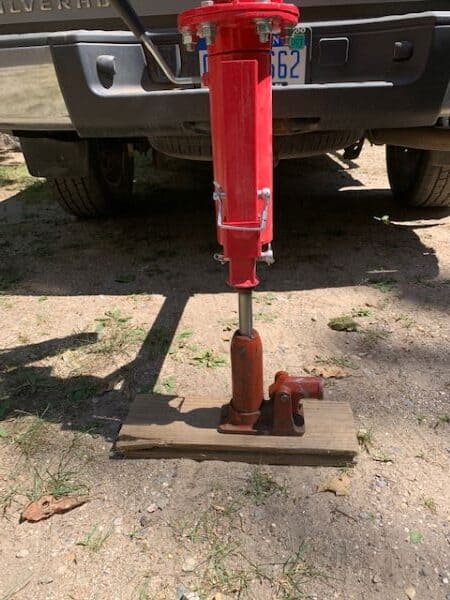
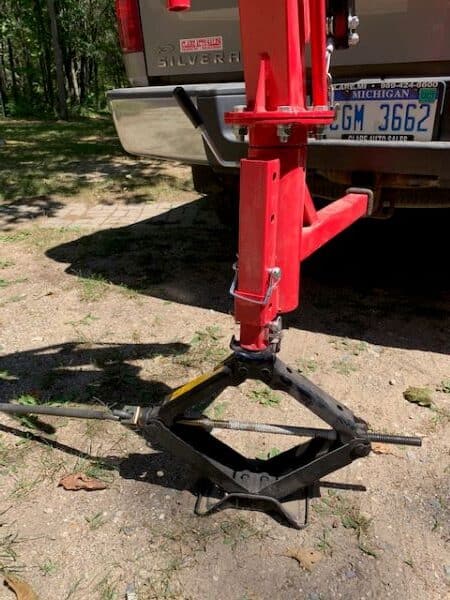
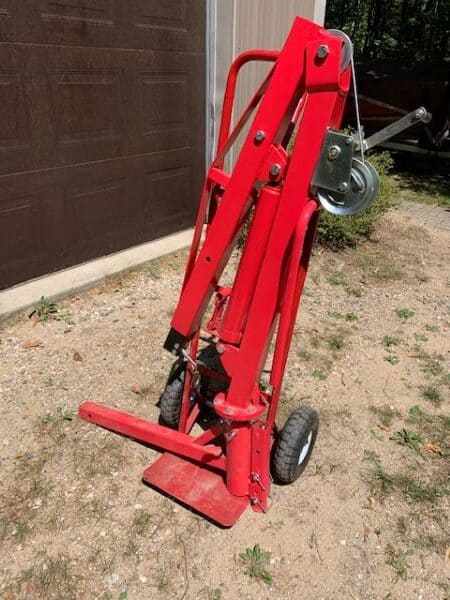
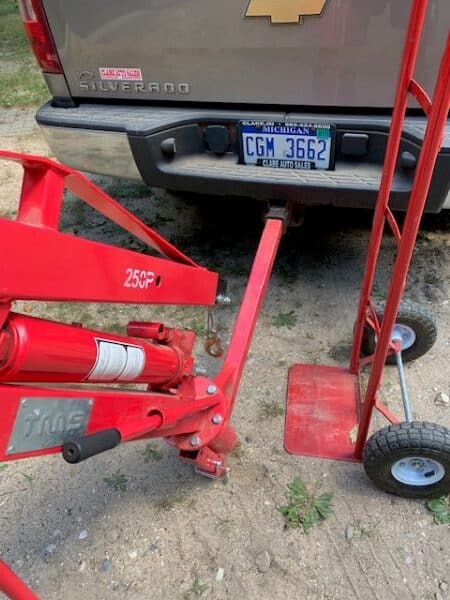
We’re glad you like it.
Hello there! I could have sworn I’ve been to this website before but after checking through some of the post I realized it’s new to me. Nonetheless, I’m definitely delighted I found it and I’ll be bookmarking and checking back frequently!
Thank you!
Good info. Lucky me I reach on your website by accident, I bookmarked it.
Those are great questions and the ones you should be asking before buying a truck crane hoist. The red hoist I have, and highlight in the article, is rated for 500 pounds. It would work on most deer species, like whitetail and mule deer, but animals like elk, moose, and larger bears would be too big for that hoist. A hoist rated for 1000 pounds would work for elk and black bears. If your husband hunts moose, brown bears, or other large animals, then mature animals can easily exceed 1000 pounds. As for the support leg height, the leg on the red model extends down 18-1/2 inches. You can always use wood blocks for extra height and it also helps support the leg on soft soil and helps to keep it from sinking in. I hope this helps.
Hi. My husband hunts. Does this lift system accommodate lifting game?
Also, does the support leg work for a truck with a lift kit?
Thanks in advance for your input.
Very interesting information!Perfect just what I was looking for!
The hitch mounted pickup cranes are great for smaller lifts around the home and shop. You never want to lift anything over the crane rating, or that you’re uncomfortable lifting. For larger, critical lifts a service such as your “linebacker crane truck” is certainly the way to go. Thanks for weighing in.
I liked that you showed how to go about hooking up a crane. It does seem like a good thing to get an expert to help with a bigger type of crane. Thanks for explaining that I will want to check the strength of the crane.